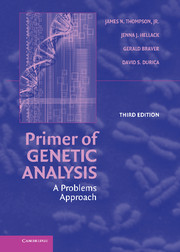Book contents
- Frontmatter
- Contents
- Preface
- Note on Genetic Symbols
- 1 Overview of Genetic Organization and Scale
- 2 Mitosis and Meiosis
- 3 Nucleic Acids: DNA and RNA
- 4 Basic Mendelian Genetics
- 5 Probability and Chi-Square
- 6 Sex-Linkage and Gene Interactions
- 7 Pedigree Analysis
- 8 Overview of Basic Statistical Testing
- 9 Quantitative Inheritance
- 10 Overview of Genetic Mapping
- 11 Assessing Chromosome Linkage Relationships
- 12 Linkage and Mapping in Diploids
- 13 Mapping in Bacteria and Viruses
- 14 Overview of Types of Genetic Change
- 15 Gene Mutation
- 16 Changes in Chromosome Number and Structure
- 17 Protein Synthesis and the Genetic Code
- 18 Gene Regulation and Development
- 19 Overview of Molecular Biology Techniques
- 20 DNA Mapping and Human Genome Analysis
- 21 Basic Population Genetics
- 22 Selection and Evolution
- 23 Practice Tests
- 24 Answers to Practice Tests and Crossword Puzzles
- 25 Landmarks in the History of Genetics
- Glossary
- Reference Tables
16 - Changes in Chromosome Number and Structure
Published online by Cambridge University Press: 05 June 2012
- Frontmatter
- Contents
- Preface
- Note on Genetic Symbols
- 1 Overview of Genetic Organization and Scale
- 2 Mitosis and Meiosis
- 3 Nucleic Acids: DNA and RNA
- 4 Basic Mendelian Genetics
- 5 Probability and Chi-Square
- 6 Sex-Linkage and Gene Interactions
- 7 Pedigree Analysis
- 8 Overview of Basic Statistical Testing
- 9 Quantitative Inheritance
- 10 Overview of Genetic Mapping
- 11 Assessing Chromosome Linkage Relationships
- 12 Linkage and Mapping in Diploids
- 13 Mapping in Bacteria and Viruses
- 14 Overview of Types of Genetic Change
- 15 Gene Mutation
- 16 Changes in Chromosome Number and Structure
- 17 Protein Synthesis and the Genetic Code
- 18 Gene Regulation and Development
- 19 Overview of Molecular Biology Techniques
- 20 DNA Mapping and Human Genome Analysis
- 21 Basic Population Genetics
- 22 Selection and Evolution
- 23 Practice Tests
- 24 Answers to Practice Tests and Crossword Puzzles
- 25 Landmarks in the History of Genetics
- Glossary
- Reference Tables
Summary
STUDY HINTS
Errors in mitosis and meiosis can lead to aneuploid cells, that is, to cells that have more or fewer chromosomes than the normal diploid (the euploid, or literally “true multiple”) set of chromosomes. Because so many genes are involved in this change in the genetic makeup of a cell, most aneuploids die or are very abnormal. Among those that do survive, however, the addition of a chromosome is apparently more readily tolerated than is the loss of a chromosome.
A related type of genomic change is polyploidy, in which fusion of meiotic products, multiple fertilization, or defects in spindle formation result in extra complete sets of chromosomes (3n, 4n, and so forth). Although polyploidy can occur in either animals or plants, it is much more common in plants. Indeed it is an important evolutionary mechanism in plants that can yield new species. It is also a valuable tool of plant breeders who want to combine characteristics from separate but related species for agricultural purposes. Seedless polyploids are also economically useful.
It is useful to distinguish two types of polyploidy. Autopolyploidy (auto- means “self”) occurs when an inhibition of normal meiosis or other processes increases the number of chromosome sets within a single species. For example, species A (where 2n = AA) becomes an autotriploid (3n = AAA), autotetraploid (4n = AAAA), or higher multiple. Allopolyploidy (allo- means “different”), on the other hand, combines chromosome sets from different species.
- Type
- Chapter
- Information
- Primer of Genetic AnalysisA Problems Approach, pp. 142 - 155Publisher: Cambridge University PressPrint publication year: 2007



